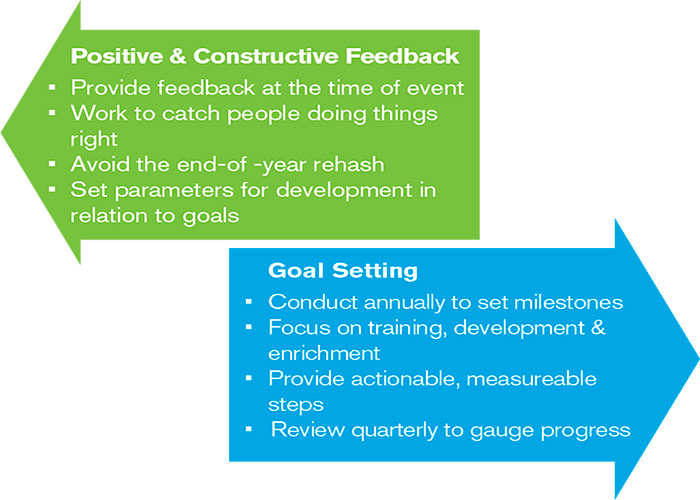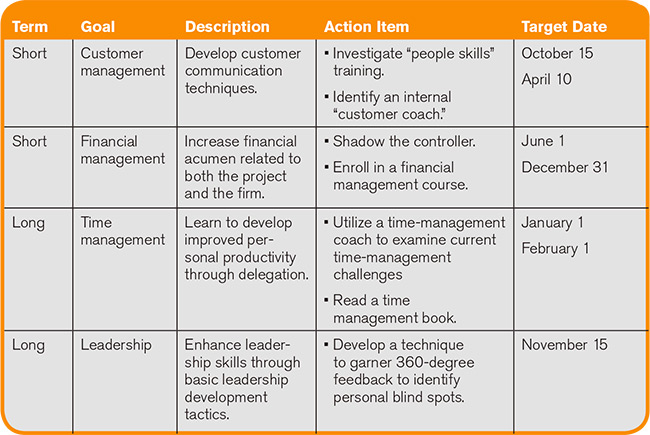
Annual performance appraisals typically evoke a feeling of dread, but it is hardly because of the feedback provided during these personnel development sessions. Interestingly enough, it is the thought of sifting through reams of paper, grading a procession of subordinates and the monotony of boring “years in review” that turn people off. Who wouldn’t find this activity draining?
While the reviewer’s job has all the appeal of a sandpaper massage, the reviewee gets to participate in a watered-down version of “This is Your Life,” complete with a recap of every failure, misgiving and error that occurred during the last 52 weeks. Feedback is important, and sometimes we guard employees from the truth. In a world that has possibly become a tad overprotective, we all cringe at the thought of giving or receiving feedback, however constructive it may be.
 Figure 1
Figure 1Best-in-class firms have morphed this annual rite of passage from the annual performance review into goal-setting exercises. First, organizations need to become more immediate in their feedback delivery. Waiting until January to provide feedback is inefficient and hardly the mark of superior leadership. There should be a forum for providing a developmental infrastructure that focuses on growing the most important cog of the construction machine—the team. By changing the current mindset, firms can grow their people more effectively and identify the career paths of their employees early. Figure 1 below can guide you toward a better start to this process. Truly progressive organizations have a robust tool and vehicle to proactively grow their teams. The fallacy is that so many firms use this annual meeting to handle all of their personnel needs. Additionally, when done inappropriately, it often takes on the following forms:
- The rehash—In some organizations, the only feedback provided is of the negative variety.
- Infinite parameters—No one can argue that superintendents, managers and estimators have multifaceted roles. However, there should be a condition that accompanies a performance review to evaluate people over several different categories.
- Stuck in the past—There is never a focus on what should happen in the next 365 days.
In regards to feedback, there are many firms that simply forget to congratulate or provide a compliment. The construction industry is ripe for change in this department. Begin this entire process by looking to catch people doing things right in your organization. We are quick to point out the margin erosion, safety hazard and construction rework. This is an easy problem to remedy, but leaders must take the time to acknowledge what is working. It also begins to create an easier model to provide those stickier feedback items. Rather than a performance review, the entire process should be entitled “goal setting.” With a new focus on the short- and long-term targets of an individual, the firm can not only provide meaningful positive and constructive feedback, but it can also craft career targets.
Set a personal vision that is mutually understood by both the appraiser and the employee. The context of the discussion will vary if an individual has a desire to become a senior project manager, a general superintendent or even a senior executive. While these may be long-term goals, targets in the short and long term will help prepare them appropriately. For instance, individual goal setting might resemble the schedule in Figure 2.
 Figure 2
Figure 2An important caveat of this process is tempering goals that balance the near-term improvements for the current position but also allows for long-term growth. Put another way, this is in no way compromising an individual’s shortcomings by solely focusing on their next step in their career progression. However, so many firms maintain a myopic view and barely have a clue as to what the associates of their firm want to do with their careers. Regardless of an individual’s career trajectory, the best mechanism to ensuring everyone is on the same page is to just ask.
The most important element of this process involves the frequency; the aim is to provide quarterly examinations. This is not about conducting a full-fledged review, but rather a reconnection to ensure the individual has been achieving actionable results. Too often, if an appraisal has goals, those goals are frantically crammed into the remaining weeks of the year with little emphasis on quality. The good news is we cross something off the list, but the bad news is there is little learned in the process.
Growing the next generation in all of our organizations is the prime directive. Consider the time an investment in your future as much as your team’s future.
